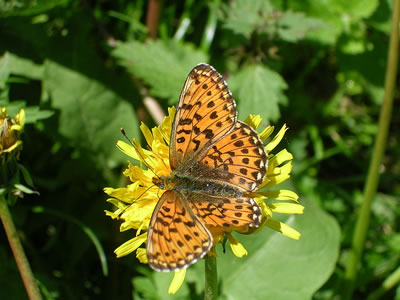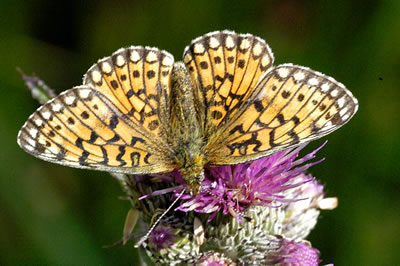Butterfly – Fritillaries

Facts about creatures
- Home
- Animal Classification
- Animal Habitats
- Amphibians
- Arthropods
- Bats
- Birds
- Carnivorans
- Cetaceans
- Chordates
- Crustaceans
- Dinosaurs
- Diprotodonts
- Elephants
- Fish
- Golden Mole
- Insects
- Lagomorphs
- Mammals
- Mammal Teeth
- Marsupial Mole
- Metamorphosis
- Mollusks
- Primates
- Reptiles
- Rodents
- Ruminants
- Soricomorphans
- Tenrec
- Tetrapods
- Vertebrates
Butterfly – Fritillaries
Fritillary butterflies share a similar pattern on their upper surface – a complex mixture of dark markings on a light background.
These butterflies are named after the snake’s head fritillary flower, which has a similar pattern.
The fritillaries belong to the subfamily Heliconiinae, also known as longwings.
In Great Britain, most species of fritillary butterfly hibernate in shriveled violet leaves when they are caterpillars.
In the spring, when the violet leaves begin to grow, the caterpillars wake up and start to feed.
Male fritillary butterflies have special scent glands on their wings. They enable females to recognize males of their own species
Fritillaries produce jut one generation of offspring of each year.
Members of the group of fritillaries known as Argynninae can be distinguished from other fritillaries by their orange-brown wings and by silver marks on the undersides of their wings.


The pearl-bordered fritillary (Boloria euphrosyne) and the small pearl-bordered fritillary (Boloria selene) are smaller fritillaries. They fly in spring and summer, when they visit flowers, such as bugle and thistle, for nectar.
These two species of butterfly lay their eggs on violet leaves.
Within 10 to 14 days, the eggs hatch.
The caterpillars feed immediately. In the next five or six weeks, they molt three times.
Each caterpillar than hibernates in a shriveled leaf at the base of its plant.
Most pearl-bordered caterpillars hibernate from July to March. In March, they begin to feed once more.
They molt one more time, and then enter a chrysalis stage, which lasts, from 10 to 14 days.
Larger fritillaries, including the silver-washed fritillary (Argynnis paphia) and the high brown fritillary (Fabriciana adippe), fly in July and August, visiting the flowers of brambles and thistles.
The dark green fritillary (Argynnis aglaja) another large fritillary butterfly, can be found in forests, as well as in open areas, such as cliff tops or sand dunes, where violets grow.
These three large fritillaries have lifecycles that are designed to ensure that the caterpillars begin to eat as early as possible in the spring.
The silver-washed fritillary is one of only a few species of butterfly that does not lay its eggs on the plant that the caterpillar eats.
The female lays her eggs in a tree trunk next to a clump of violets. The caterpillars hatch in early fall and then hibernate in a crevice in the bark.
In the spring, the caterpillar travels down to the ground to search for violet plants.
The high brown fritillary lays its eggs low down on the stems of violets. The caterpillars remain in the eggs until spring.
The dark green fritillary lays its eggs on the leaves or stems of violets. In a little over two weeks, the young caterpillars hatch. They immediately move to the bottom of the plant where they find shriveled leaves in which to hibernate.